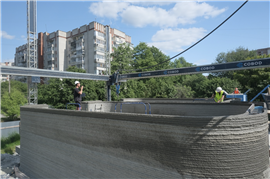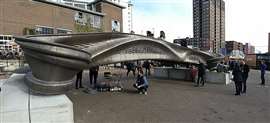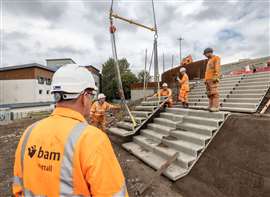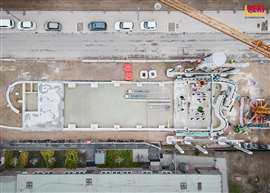What does the future look like for 3D construction printing?
13 July 2023
Few recent projects have illustrated the potential of 3D printing in construction as effectively as the reconstruction of the walls of 370 sq m school in Lviv, in Ukraine.
The high-profile scheme saw Danish 3DCP Group used Cobod’s BOD2 printer for the one-storey building, using locally sourced concrete.
The four-day build involving just a handful of people showed off some of 3D printing’s chief advantages – speed and a lack of reliance on skilled labourers, perhaps even more scarce in war-torn Ukraine than in many other parts of the world. Then there’s the potential for more economical use of concrete, lower wastage and, consequently, lower embodied carbon.
And yet even after several years of development, 3D printing in construction not all that widespread.
So where does it go from here in terms of its wider adoption? And what new advancements in technology could help spur that adoption?
Real-world 3D printing arriving
Luca Stabile, a director of Arup in Italy, based in Milan, led a project to build Europe’s first 3D-printed house as a demonstrator for Design Week in Milan in 2018. The 100 sq m, one-storey house, called 3D Housing 05, was built in concrete using a robot from Dutch 3D printing specialist CyBe.
 A COBOD 3D printer prints the walls of the single-storey school in Lviv (Image: COBOD)
A COBOD 3D printer prints the walls of the single-storey school in Lviv (Image: COBOD)
As with any new technology, there was an initial flurry of interest before it died down as work to assess its performance, Stabile says. But now he sees 3D printing entering a new phase where it starts to have practical, real-world applications.
“We are convinced that we can go beyond the pavilions and the demonstrators and there is the potential for many more real applications than in the past,” he says.
His colleague, Amsterdam-based Mathew Vola agrees. Arup was lead structural engineer on a project to build the world’s first 3D-printed steel bridge in collaboration with Dutch technology company MX3D, which has been installed in Amsterdam’s red light district.
“3D printing is going to grow exponentially,” Vola says.
“And as skilled labour reduces, we are going to become more dependent on these types of technologies. In the Netherlands, we can’t find anymore bricklayers. Robots are getting better and better at printing and they don’t need much skilled labour comparable to more traditional methods of construction, even in a factory.”
Henrik Lund-Nielsen, whose Denmark-based company Cobod supplies gantry-based 3D printers to construction companies around the world, also sees the potential for major growth.
“Our company started in 2018 and we had eight people. We have more than 100 now and sales are around €20 million. So it has gone very fast,” he says.
“You have small, entrepreneurial organisations adopting 3D printing to disrupt the construction sector and then we also have much larger customers who clearly see it as part of the future and understand that we are just scratching the surface here.”
 MX3D’s 3D printed bridge at Dutch Design Week in Eindhoven (Image: IIVQ / Tijmen Stam, CC BY-SA 4.0 via Wikimedia Commons)
MX3D’s 3D printed bridge at Dutch Design Week in Eindhoven (Image: IIVQ / Tijmen Stam, CC BY-SA 4.0 via Wikimedia Commons)
3D printing’s use case is evolving
Up until now, 3D printing in construction is probably most closely associated with housing. One of the world’s first projects involved Shanghai-based engineering company WinSun building a 3D-printed villa and flats in China’s Jiangsu Province in 2015. More recently, US 3D printing company Icon announced late last year that it would 3D print 100 houses at Wolf Ranch in Georgetown, Texas in partnership with US housebuilder Lennar.
But that is starting to change as the technology evolves, Lund-Nielsen explains. “When you have a relatively small printer that can extrude a concrete-like material, you think about making a little house, right?,” he says.
 Digital render of how the 3D-printed building will look (Image supplied by Cobod)
Digital render of how the 3D-printed building will look (Image supplied by Cobod)
“That’s how it started and spurred the first interest from people. But it’s not, in my opinion, the most interesting application – there are others.”
He points out that while 3D concrete printing can handle walls and foundations and potentially also the roof, this represents only 25%-40% of the structure of a house. Where 3D printing can’t help currently is with plumbing, electricity, wooden floors, or marble bathroom fittings, for example.
“But there’s lots of other applications where basically it is only reinforced concrete,” he says. “You can think about bridges, tunnels, wind turbine bases, tanks, silos and industrial warehouses. These are more raw structures and we are trying to convince our customers to look in that direction because it can have a much bigger impact.”
It’s a similar line of thinking to the one that Stabile has adopted, in the wake of the deadly floods to have swept his home country of Italy this year.
“One of the main issues we have now is that we have to rebuild the infrastructure and make cities more resilient. 3D printing can be used to create tanks and bespoke stormwater collection,” he suggests. “It’s not fancy, but it’s useful.”
It will also play an important role in disaster-struck areas – the school in Ukraine serving as just one example – as well as for facilities like military barracks that could require rapid construction, he and Vola predict.
 Weber Saint Gobain has opted to specialise in load-bearing 3D-printed structures like bridges and slope stairs (Image: Weber Saint Gobain)
Weber Saint Gobain has opted to specialise in load-bearing 3D-printed structures like bridges and slope stairs (Image: Weber Saint Gobain)
Meanwhile, 3D printing specialist Weber, part of construction products giant Saint Gobain, has decided to focus on 3D printing concrete in factory conditions to make slope stairs, and other load-bearing structures like bridges.
Business unit manager Peter Paul Cornelissen is “100% confident” that 3D printing will grow and says the ultimate goal is that it is considered as a means of production alongside casting and moulding concrete.
Limitations and obstacles
But there’s no doubt though that there are headwinds when it comes to the wider adoption of what is still a nascent technology.
Some of those are technological – gantry printers are currently limited by how high they can build and in the case of Cobod, this is around the 9m mark at the moment. However, Lund-Nielsen is confident that this will change soon and that the technology exists to allow its printers to go as high as seven storeys.
Certification, regulatory environments, and a traditional mindset among some people within the construction industry could prove tricker to solve.
Vola sees certification as an issue but adds, “people are interested in getting involved in 3D printing and that’s something that can be overcome”.
Regulation is more difficult though. “We experienced that on our 3D printed bridge. To get someone to approve it on the government side was a bigger challenge than designing it and maybe even constructing it, although that wasn’t an easy feature either,” Vola says.
Regulation also varies by country. The regulatory regime in the Netherlands is actually more flexible than some, Vola says. “If you test something rigorously, you can say: ‘Well, we tested it rigorously so it will likely work.’ And that was our way around it. There are many countries where regulation is very top-down and there’s no engineering judgement allowed.”
In those countries, a more piecemeal, hybrid approach may be required, where 3D-printed components are mixed with more traditional building methods. “There are no codes for 3D printing at the moment, so to continue with it you need to test and prove the technology. A hybrid model could be the best way to progress,” Stabile says.
Cornelissen agrees that certification and building codes will take a long time to catch up. In the meantime, Weber has developed a strong relationship with the Eindhoven University of Technology in order to test and validate the technology in a bid to increase confidence and drive adoption.
He also highlights Weber’s rigourous quality control programme, producing 3D-printed elements in factory conditions. “The dry mortar we get from Weber is certified and when you add the water we have parameters to control the viscosity and the temperature - and all of this is included in the quality reports for the printed parts,” Cornelissen says. “And I think that is key to persuade the market and the the organisations that permit and sign off on these objects.”
 UK contractor BAM Nuttall installed the UK’s first 3D-printed staircase to a bridge across the M8 in Glasgow in 2022, using elements printed by Weber Saint Gobain (Image: Weber Saint Gobain)
UK contractor BAM Nuttall installed the UK’s first 3D-printed staircase to a bridge across the M8 in Glasgow in 2022, using elements printed by Weber Saint Gobain (Image: Weber Saint Gobain)
Meanwhile, US builder Icon recommends maintaining a close working relationship with regulators. “Consumers are excited about this new technology for sure but construction is the largest industry on earth and it takes a lot of time to steer a ship that big,” says Michael Harper, Icon’s director of business development.
“For example, building departments and regulatory bodies are intentionally risk averse, and for a lot of good reasons. We work very closely with authorities of jurisdictions and regulatory organizations to ensure that we’re meeting or exceeding existing building guidelines and acceptance criteria,” he adds.
The complications of differing local regulatory regimes is why Cobod has set itself up as a technology supplier, rather than a construction company, Lund-Nielsen says.
He prefers to let individual clients working in those markets find their way around the regulatory hurdles, albeit with the company offering advice where it can. “We focus on making the best technology. We tell our customers about the methods being used by the other customers regarding authorities and permits. And then they figure out on the basis of the rules that they have, which methods are the best ones to use.”
Cobod also tries to encourage dialogue between customers, particularly those based in different markets who aren’t competing with each other. “The Irish can speak to the Canadians, for example. Or the Canadians can speak to the Californians, and so on,” Lund-Nielsen adds.
Technological advancements
While still a relatively new technology, 3D printing is advancing rapidly.
“If you look at MX3D and the quality of the 3D printed bridge and the speed it was printed at compared to what they do now, it’s a different ballgame,” Vola says. “All these companies are getting better and better at it.”
He explains that 3D printers, regardless of the material they are working with are getting bigger, and therefore able to print larger volumes, as well as faster.
Meanwhile, there’s the potential for what was a mono-material process to start involving multiple materials to allow for more complex structures.
 Aerial view of the construction of the server hotel in Heidelberg, Germany (Image: Peri/Cobod)
Aerial view of the construction of the server hotel in Heidelberg, Germany (Image: Peri/Cobod)
He points to tests that have been done with timber pulp, which would allow printing with waste timber materials. Highlighting the possible advantages 3D printing can bring when it comes to circularity, he says, “If you imagine how much waste timber there is in the world then it becomes very interesting. If we could upgrade waste material, turn it into pulp, and build our buildings with it then imagine what that could do for your carbon footprint.”
Then there is the continuous improvement of the steering mechanism of the printer itself, allowing them to become more precise and producing an end product that is cheaper as well as better, he asserts.
For Cornelissen, it’s less about making more technological advancements and more about convincing the market to adopt the technology. “We need to show to the market what is possible so that the market can come to us and say, ‘Guys, if this is possible, it would be great if you could help us with this’,” he says.
Meanwhile, Lund-Nielsen says Cobod is devoting a considerable amount of its time and effort towards research and development. He considers how the company’s gantry system, which currently carries a print head through three dimensions with millimetre precision could be used for other types of tools.
“We have the capability to place a tool and the ability to give it materials. Why couldn’t it also do insulation or painting, for example?” he asks.
“We are going from being a manufacturer of 3D construction printers to making multifunctional construction robots based on 3D printing technologies.”
And he sums up the future for 3D printing in construction in four words: “Faster, taller, more automation.”
STAY CONNECTED



Receive the information you need when you need it through our world-leading magazines, newsletters and daily briefings.
CONNECT WITH THE TEAM








